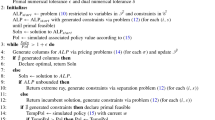Abstract
We present two new methods to stabilize column-generation algorithms for the temporal knapsack problem (TKP). Caprara et al. (INFORMS J Comp 25(3):560–571, 2013] were the first to suggest the use of branch-and-price algorithms for Dantzig–Wolfe reformulations of the TKP. Herein, the respective pricing problems are smaller-sized TKP that can be solved with a general-purpose MIP solver or by dynamic programming. Our stabilization methods are tailored to the TKP as they use (deep) dual-optimal inequalities, that is, inequalities known to be fulfilled by all (at least some) optimal dual solutions to the linear relaxation. Extensive computational tests reveal that both new stabilization techniques are helpful. Several previously unsolved instances are now solved to proven optimality.



Similar content being viewed by others
References
Bartlett M, Frisch A, Hamadi Y, Miguel I, Tarim S, Unsworth C (2005) The temporal knapsack problem and its solution. In: Barták R, Milano M (eds) Integration of AI and OR techniques in constraint programming for combinatorial optimization problems, Lecture notes in computer science, vol 3524, Springer, Berlin, pp 34–48, doi:10.1007/11493853_5
Ben Amor H, Desrosiers J, Valério de Carvalho JM (2006) Dual-optimal inequalities for stabilized column generation. Oper Res 54(3):454–463. doi:10.1287/opre.1060.0278
Caprara A, Malaguti E, Toth P (2011) A freight service design problem for a railway corridor. Transp Sci 45(2):147–162. doi:10.1287/trsc.1100.0348
Caprara A, Furini F, Malaguti E (2013) Uncommon Dantzig-Wolfe reformulation for the temporal knapsack problem. INFORMS J Comput 25(3):560–571
Caprara A, Furini F, Malaguti E, Traversi E (2016) Solving the temporal knapsack problem via recursive Dantzig–Wolfe reformulation. Inf Process Lett 116(5):379–386. doi:10.1016/j.ipl.2016.01.008
Desaulniers G, Desrosiers J, Solomon M (eds) (2005) Column generation. Springer, New York
Desrosiers J, Gauthier JB, Lübbecke ME (2014) Row-reduced column generation for degenerate master problems. Eur J Oper Res 236(2):453–460. doi:10.1016/j.ejor.2013.12.016
Dolan ED, Moré JJ (2002) Benchmarking optimization software with performance profiles. Math Program 91(2):201–213. doi:10.1007/s101070100263
du Merle O, Villeneuve D, Desrosiers J, Hansen P (1999) Stabilized column generation. Discrete Math 194:229–237
Gauthier JB, Desrosiers J, Lübbecke ME (2016) Tools for primal degenerate linear programs. EURO J Transport Logist 5(2):161–204. doi:10.1007/s13676-015-0077-5
Gilmore P, Gomory R (1961) A linear programming approach to the cutting-stock problem. Oper Res 9:849–859
Gschwind T, Irnich S (2016) Dual inequalities for stabilized column generation revisited. INFORMS J Comput 28(1):175–194
Hiriart-Urruty JB, Lemaréchal C (1993) Convex analysis and minimization algorithms, part 2: advanced theory and bundle methods, Grundlehren der mathematischen Wissenschaften, vol 306. Springer, Berlin
Kellerer H, Pferschy U, Pisinger D (2004) Knapsack problems. Springer, Berlin
Lee C, Park S (2011) Chebyshev center based column generation. Discrete Appl Math 159(18):2251–2265. doi:10.1016/j.dam.2011.08.009
Lübbecke M, Desrosiers J (2005) Selected topics in column generation. Oper Res 53(6):1007–1023
Marsten R, Hogan W, Blankenship J (1975) The boxstep method for large-scale optimization. Oper Res 23:389–405
Poggi de Aragao M, Uchoa E (2003) Integer program reformulation for robust branch-and-cut-and-price algorithms. In: Proc. Conf. Math. Program in Rio: A Conference in Honour of Nelson Maculan, Rio de Janeiro, Brazil, pp 56–61
Rousseau LM, Gendreau M, Feillet D (2007) Interior point stabilization for column generation. Oper Res Lett 35(5):660–668. doi:10.1016/j.orl.2006.11.004
Valério de Carvalho JM (2005) Using extra dual cuts to accelerate column generation. INFORMS J Comput 17(2):175–182
Vanderbeck F (2005) Implementing mixed integer column generation. In: Desaulniers G, Desrosiers J, Solomon M (eds) Column generation. Springer, New York, pp 331–358 (chap 12)
Acknowledgments
This research was funded by the Deutsche Forschungsgemeinschaft (DFG) under Grant No. IR 122/6-1.
Author information
Authors and Affiliations
Corresponding author
Electronic supplementary material
Below is the link to the electronic supplementary material.
Rights and permissions
About this article
Cite this article
Gschwind, T., Irnich, S. Stabilized column generation for the temporal knapsack problem using dual-optimal inequalities. OR Spectrum 39, 541–556 (2017). https://doi.org/10.1007/s00291-016-0463-x
Received:
Accepted:
Published:
Issue Date:
DOI: https://doi.org/10.1007/s00291-016-0463-x




